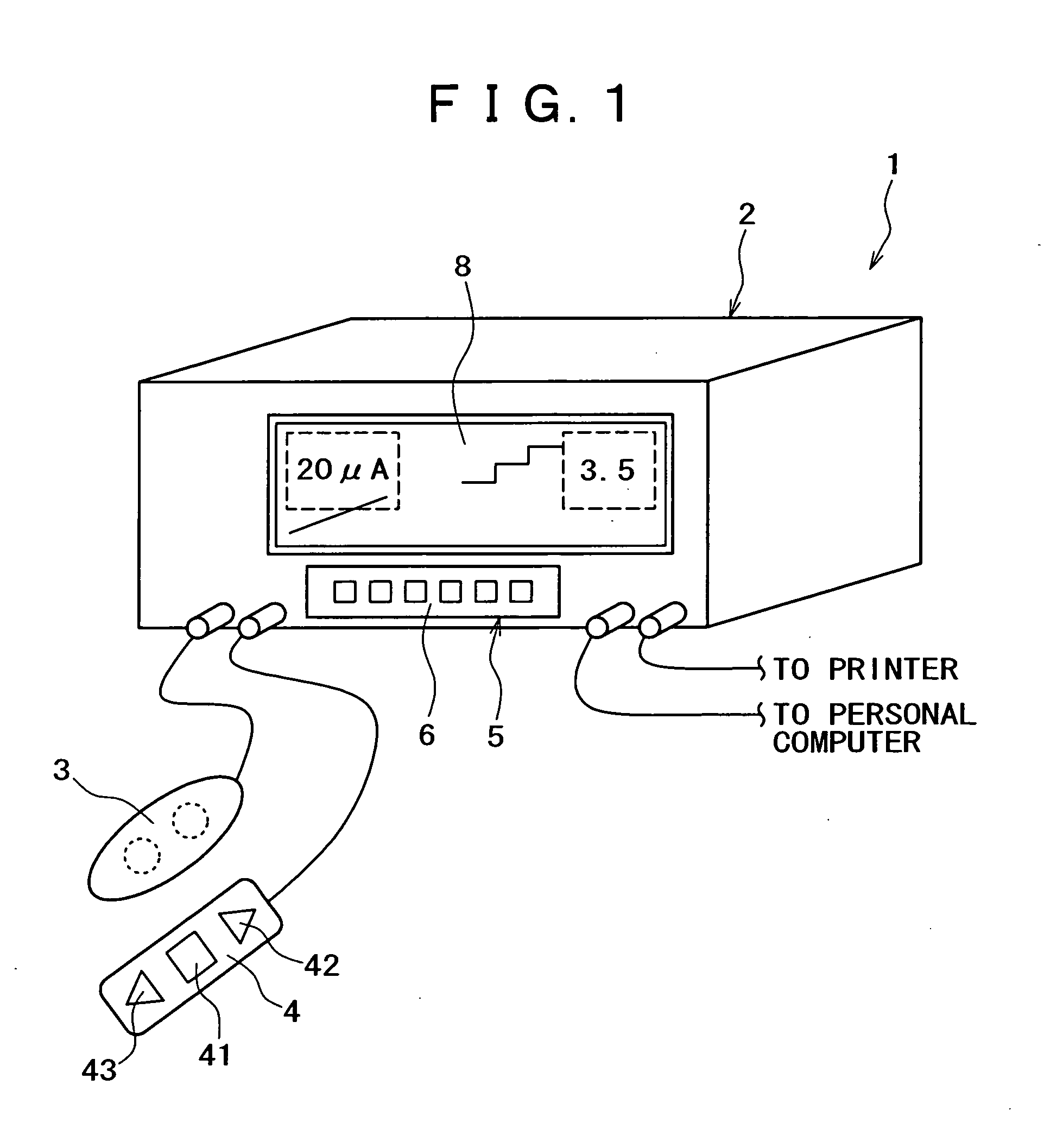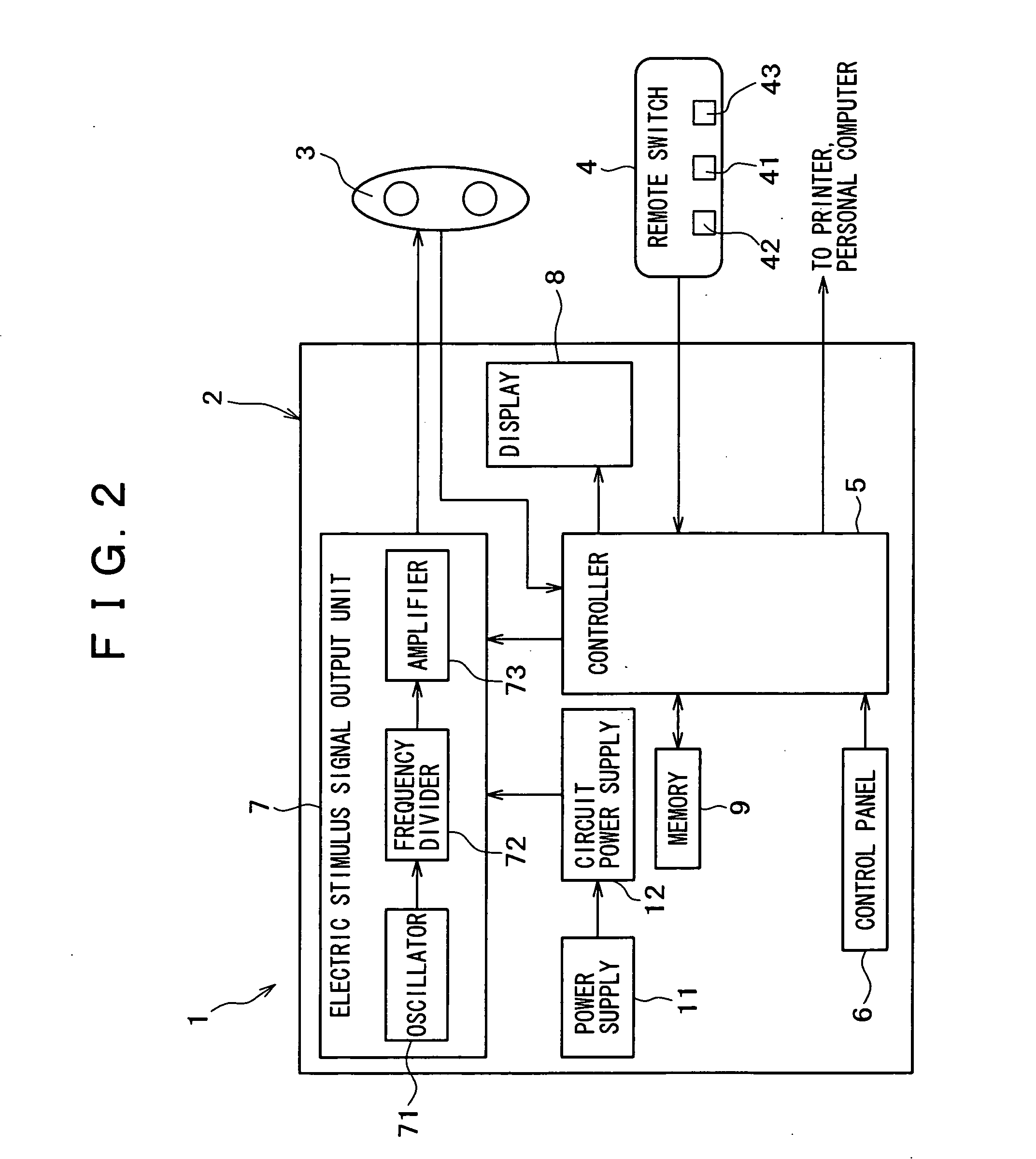Pain measurement system and method of measuring pain
a measurement system and pain technology, applied in the field of pain measurement system and pain measurement method, can solve the problems of difficult comparison of pain measured magnitudes between different patients, difficulty in properly expressing pain magnitude, and failure to achieve the effect of reducing irregularity and reducing irregularity
- Summary
- Abstract
- Description
- Claims
- Application Information
AI Technical Summary
Benefits of technology
Problems solved by technology
Method used
Image
Examples
first embodiment
[0062] A pain measurement system 1 according to the present invention as shown in FIGS. 1 through 3 applies an electric stimulus (an electric stimulative sensation), particularly a painless electric stimulus (painless stimulus), which is different from pain experienced by a patient (examinee). The system 1 compares the magnitude of the electric stimulus and the magnitude of actual pain (measured pain) to quantify the magnitude of the pain in the patient.
[0063] When a certain electric stimulus (a current under certain conditions) is applied to a patient, the patient develops a painless sensation such as a numb sensation (vibratory sensation). When the electric stimulus, i.e., the magnitude of the current, increases or decreases, the magnitude of the sensation developed by the patient also increases or decreases. Therefore, the magnitude of pain can be measured without having the patient feel pain due to the measurement, by comparing the magnitude of the electric stimulus (the sensati...
second embodiment
[0157] A pain measurement system according to the present invention will be described below.
[0158]FIG. 7 is a diagram illustrative of the manner in which the pain measurement system according to the second embodiment of the present invention operates.
[0159] The pain measurement system, also denoted by 1, according to the second embodiment will be described below basically with respect to differences with the pain measurement system according to the first embodiment. Those details of the pain measurement system 1 according to the second embodiment which are the same as the pain measurement system according to the first embodiment will not be described in detail below. The pain measurement system 1 according to the second embodiment operates in the third step as follows: In the step-up control mode, the current value of a pulse current (the magnitude of a stimulus) increases stepwise by nX, and the time during which it stays in each step changes, and in the step-down control mode, th...
third embodiment
[0164] A pain measurement system according to the present invention will be described below.
[0165]FIG. 8 is a diagram illustrative of the manner in which the pain measurement system according to the third embodiment of the present invention operates.
[0166] The pain measurement system, also denoted by 1, according to the third embodiment will be described below basically with respect to differences with the pain measurement system according to the first embodiment. Those details of the pain measurement system 1 according to the third embodiment which are the same as the pain measurement system according to the first embodiment will not be described in detail below.
[0167] The pain measurement system 1 according to the third embodiment performs a measuring process at least twice.
[0168] For example, if the pain measurement system 1 performs a measuring process twice, then, in the first measuring process, the current value of a pulse current increases at a substantially constant rate ...
PUM
 Login to View More
Login to View More Abstract
Description
Claims
Application Information
 Login to View More
Login to View More - R&D
- Intellectual Property
- Life Sciences
- Materials
- Tech Scout
- Unparalleled Data Quality
- Higher Quality Content
- 60% Fewer Hallucinations
Browse by: Latest US Patents, China's latest patents, Technical Efficacy Thesaurus, Application Domain, Technology Topic, Popular Technical Reports.
© 2025 PatSnap. All rights reserved.Legal|Privacy policy|Modern Slavery Act Transparency Statement|Sitemap|About US| Contact US: help@patsnap.com



